By Doug Winter – RareGoldCoins.com highlights US gold Coins ……
CoinWeek Content Partner ……
I’m not sure if it’s a trend or not but in the last few months I’ve encountered a number of collectors who are working on a year-set of US gold coins.
* * *
A year-set focuses on a specific US Gold coins year of issue and attempts to include an example of each date/mint combination. A year-set can be a somewhat random selection, or it can have numismatic/personal significance.
If I were to choose to collect in this manner, my first choice would likely be an 1859 gold set as this would mark exactly 100 years before my birth. But this isn’t the most interesting coinage year from a numismatic or historic perspective.
Before you decide which year to collect, you need to analyze what was produced during that year. Certain years, such as 1841, 1854, and 1863, are going to be immediate no-gos for most collectors due to the extreme rarity and high cost of at least one issue. Other US gold coin years contain mainly uninteresting coins and a specialized set of, say, 1899 gold coins just isn’t a worthwhile project.
If I were assembling a US gold coin year set, I would focus on a year in which the coins themselves were interesting and scarce but not impossible to locate. A few years come to mind and these are as follows: 1838, 1839, 1840, 1842, 1855, and 1866.
Let’s look at these five years and in the true spirit of a DWN blog, let’s rate them as well.
Here’s our rating system:
- Level of Numismatic Interest: 1-5 (1=least, 5=most)
- Degree of Difficulty: 1-5 (1=least, 5=most)
- Rarity in High Grades: 1-5 (1=least, 5=most)
1838
This is an interesting year as it bridges the gap between early gold and the more standardized Liberty Head issues. It consists of just six US gold coins, but nearly everyone is interesting and most are either first-year issues or one-year types (or both).
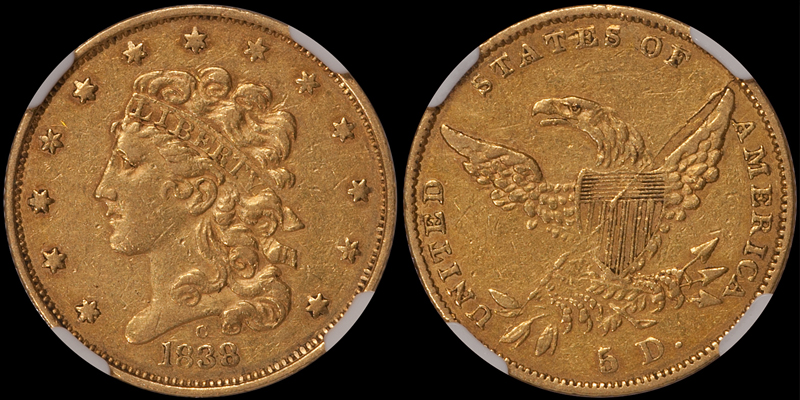
1838-C $5.00 NGC AU50 CAC. Images courtesy Douglas Winter Numismatics (DWN)
The most expensive coins in this set are likely to be the 1838-C half eagle and the 1838 eagle. Both are available for less than $10,000 in very respectable preservation, but both are challenging; especially with original color and a CAC-worthy appearance.
In my opinion, this set is best combined with the 1839 to form a really interesting two-year focus which features a number of high-interest issues.
- Level of Numismatic Interest: 4
- Degree of Difficulty: 2+/3
- Rarity in High Grades: 3
1839
The 1839 is a fascinating transitional year with many interesting one-year types. As with the 1838, it focuses on issues with the mintmark located on the obverse. The 1838 features the Classic Head design, while the 1839 employs the first incarnation of the Liberty Head design. It consists of 10 different issues. With significant varieties included, this number can be pushed higher.

1839 SMALL LETTERS $10.00 NGC AU53
The most expensive coin is the 1839 eagle with Small Letters on the reverse. After this come the 1839-C and 1839-D half eagles. All three of these issues will cost at least $10,000-15,000+ for a nice example, and the eagle is extremely hard to locate with original color and surfaces.
As I mentioned above, combining this set with the 1838 will create a really special group of coins and one which will be easy to sell when the time comes.
- Level of Numismatic Interest: 4
- Degree of Difficulty: 3
- Rarity in High Grades: 3+
1840
1840 is an interesting year as this marks the introduction of the familiar modified Liberty Head design with the mintmark now moved to the reverse. There are a total of nine different issues, but this can be added to if you break down the half eagles to include narrow mill and broad mill varieties.
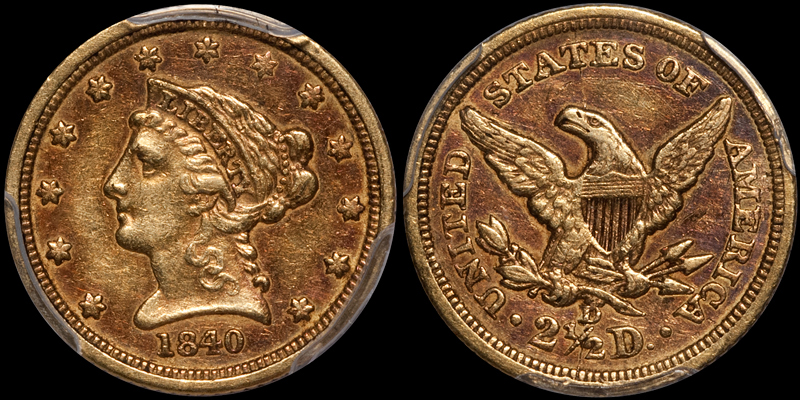
1840-D $2.50 PCGS EF45
The most expensive issue is the 1840-D quarter eagle which isn’t intimidating, but which has proven to be quite elusive in recent years. The 1840-D half eagle is the next most expensive issue.
Combining this set with the 1838 and the 1839 would be interesting, although most collectors would probably vote against this.
- Level of Numismatic Interest: 3
- Degree of Difficulty: 2+/3
- Rarity in High Grades: 3
1842
1842 is a very busy year for varieties. There are a total of 14 different issues, half of which are half eagles. As someone who is partial to half eagles, this makes 1842 an appealing year for me; your level of interest may vary.

1842-C SMALL DATE $5.00 PCGS AU55+ CAC
There are two relatively expensive us gold coins in this set: the 1842-C Small Date and the 1842-D Large Date half eagles. You are looking at $20,000 for a nice example of the former and $15,000+ for a nice example of the latter. The 1842 and 1842-D quarter eagles are not as well-known but they will prove difficult to locate with CAC-worthy appearance.
This set could be combined with an 1843 to form a very interesting overview of the experimentation that the mint was undertaking with date and lettering sizes on all three of the then-current denominations.
- Level of Numismatic Interest: 2 (3+ if you have taste similar to mine)
- Degree of Difficulty: 3
- Rarity in High Grades: 3
1855
This year is interesting due to some new designs and the large number of coins produced. By 1855, there were six circulating designs from five different mints. A grand total of 20 different issues were struck during this year and these coins range from very common to rare.
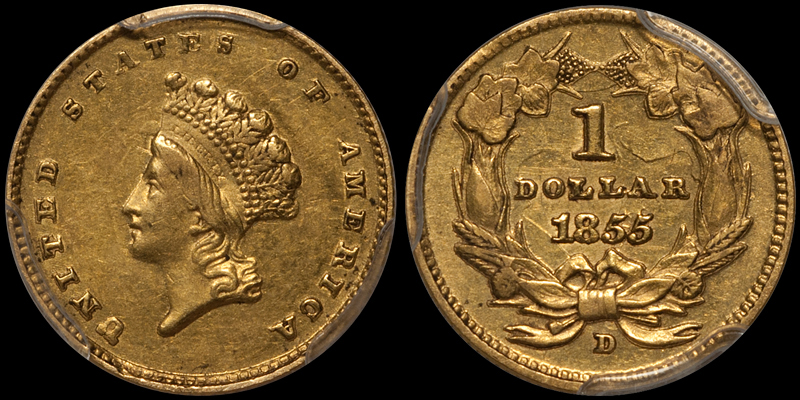
1855-D $1.00 PCGS AU53 CAC
The two key issues are the 1855-D gold dollar and the 1855-O double eagle. These are expensive issues (around $50,000 for nice examples) and both are very hard to locate with good eye appeal. The 1855-D is a touch less rare but it, too, is very challenging to locate choice.
An interesting numismatic feature of this set is the fact that there are no less than five different half eagles struck in 1855. This occurred in just three other years: 1854, 1856, and 1857.
- Level of Numismatic Interest: 2
- Degree of Difficulty: 4
- Rarity in High Grades: 3+/4
1866
Our sixth and final year-set is the 1866. This is a well-known transitional year in which the motto IN GOD WE TRUST was added to the half eagle, eagle, and double eagle. This created varieties for these three denominations from both the Philadelphia and San Francisco mints.
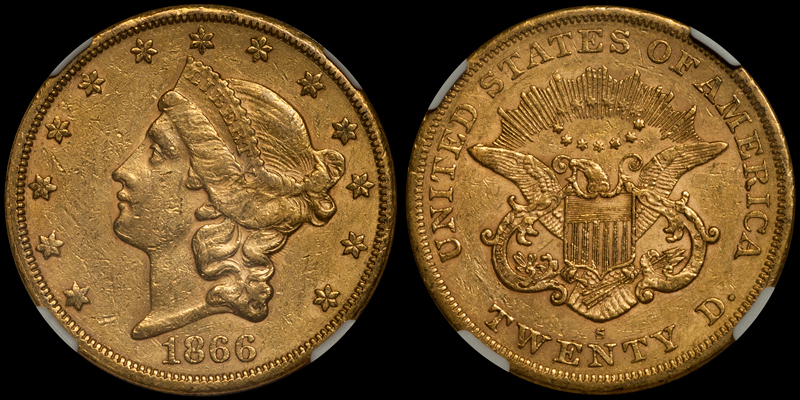
1866-S NO MOTTO $20.00 NGC AU53 CAC
The key issue in this set is the 1866-S No Motto double eagle. This date can easily run $50,000+ for a nice example. Two other rare issues are the 1866-S No Motto half eagle and eagle, but these are more affordable.
- Level of Numismatic Interest: 4
- Degree of Difficulty: 3
- Rarity in High Grades: 3
There are certainly other year-sets of interest which can be assembled by the US gold coin specialist. Some which come to mind include 1848 (the year of the Gold Rush), 1861 (the closing of the three Southern branch mints), 1875 (due to the rarity of many of the P mint issues), 1893 (the close of the Carson City Mint), and 1907 (a transitional year).
Are you working on a US Gold Coin year set? Which set(s) are you working on and why? Leave your comments below.
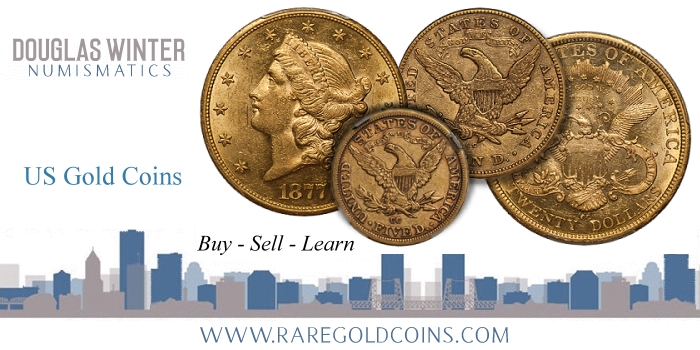
* * *
About Doug Winter
 Doug has spent much of his life in the field of numismatics; beginning collecting coins at the age of seven, and by the time he was 10 years old, buying and selling coins at conventions in the New York City area.
Doug has spent much of his life in the field of numismatics; beginning collecting coins at the age of seven, and by the time he was 10 years old, buying and selling coins at conventions in the New York City area.
In 1989, he founded Douglas Winter Numismatics, and his firm specializes in buying and selling choice and rare US Gold coins, especially US gold coins and all branch mint material.
Recognized as one of the leading specialized numismatic firms, Doug is an award-winning author of over a dozen numismatic books and the recognized expert on US Gold. His knowledge and an exceptional eye for properly graded and original coins has made him one of the most respected figures in the numismatic community and a sought after dealer by collectors and investors looking for professional personalized service, a select inventory of impeccable quality and fair and honest pricing. Doug is also a major buyer of all US coins and is always looking to purchase collections both large and small. He can be reached at (214) 675-9897.
Doug has been a contributor to the Guidebook of United States Coins (also known as the “Redbook”) since 1983, Walter Breen’s Encyclopedia of United States and Colonial Coins, Q. David Bowers’ Encyclopedia of United States Silver Dollars and Andrew Pollock’s United States Pattern and Related Issues
In addition, he has authored 13 books on US Gold coins including:
- Gold Coins of the New Orleans Mint: 1839-1909
- Gold Coins of the Carson City Mint: 1870 – 1893
- Gold Coins of the Charlotte Mint: 1838-1861
- Gold Coins of the Dahlonega Mint 1838-1861
- The United States $3 Gold Pieces 1854-1889
- Carson City Gold Coinage 1870-1893: A Rarity and Condition Census Update
- An Insider’s Guide to Collecting Type One Double Eagles
- The Connoisseur’s Guide to United States Gold Coins
- A Collector’s Guide To Indian Head Quarter Eagles
- The Acadiana Collection of New Orleans Coinage
- Type Three Double Eagles, 1877-1907: A Numismatic History and Analysis
- Gold Coins of the Dahlonega Mint, 1838-1861: A Numismatic History and Analysis
- Type Two Double Eagles, 1866-1876: A Numismatic History and Analysis
Finally, Doug is a member of virtually every major numismatic organization, professional trade group and major coin association in the US.





What do you know about a 1970 quarter of a dollar in Scott The Mark of 1941 on the back of it and no letter on the front
I am not sure if you really understand degree of difficulty. I am on the Board of two clubs, a local and a state organization, and a vast majority of our memberships would consider coins over $500 to be deal breakers. I realize that this article was written for a different segment of the hobby, but to make light of having not one but two different coins costing nearly $10,000 each is ridiculous.
I really appreciate your efforts in writing about a new trend, but you need to bring a more accurate perspective to the average collector.
Hi Marc – CoinWeek publishes articles that cover the vast spectrum of both interests and budgets when it comes to the subjects and coin articles we post and the collecting strategies put forth. I would disagree with you that we or the author in any way “make light” of the cost of these coins suggested or in any way disparage collectors with budgets that make many coins unobtainable. That is precisely why CoinWeek has literally thousands of articles about collector coins, modern issues and coins modestly priced but very desirable.